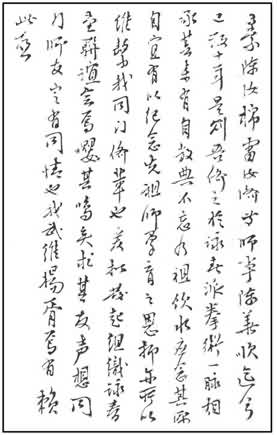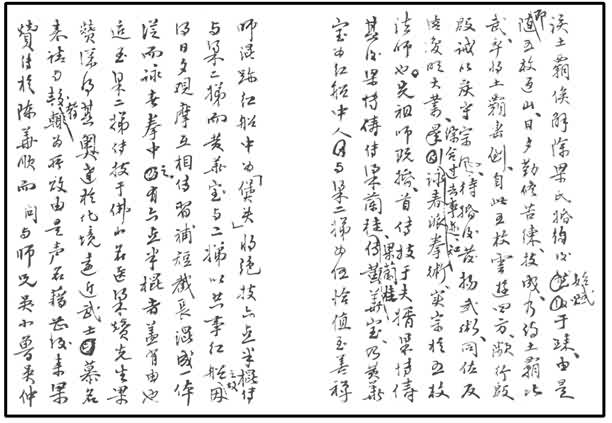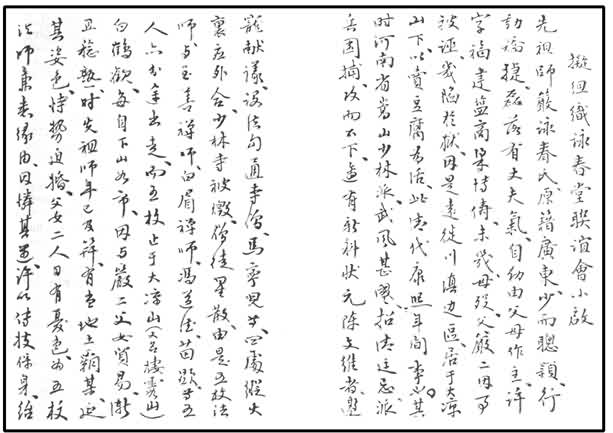
|

|

|
| |||
| Yip Man's calligraphy, draft of the preface, written in the mid 60s. |
葉問,《擬組織詠春堂聯誼會小啟》先祖師嚴詠春氏,原籍廣東,少而聰穎,行動矯捷,磊落有丈夫氣。自幼由父母作主,許字福建鹽商梁博儔。未幾,母歿。父嚴二因事被誣,幾陷於獄,因是遠徙川滇邊區,居于大涼山下,以賣豆腐為活,此清代康熙年間事也。 其時河南省嵩山少林派,武風甚盛;招清廷忌,派兵圍捕,攻而不下。適有新科狀元陳文維者,邀寵獻議,設法勾通寺僧馬寧兒等,四處縱火,裏應外合,少林寺被燬,僧徒四散。由是五枚法師與至善禪師、白眉禪師、馮道德、苗顯等五人亦分途出走。而五枚止于大涼山(又名棲霞山)白鶴觀。每自下山如市;因與嚴二父女貿易,漸且稔熟。 時先祖師年已及笄,有當地土霸某,涎其姿色,恃勢迫婚。父女二人日有憂色,為五枚法師廉悉緣由,因憐其遇,許以傳技保身,紿該土霸俟解除梁氏婚約後始于歸。由是即隨五枚返山,日夕勤修苦練。技成,乃約土霸比武,卒將土霸擊倒。自此五枚雲遊四方,瀕行殷殷誡以嚴守宗風,待婚後發揚武術,同佐反清復明大業。綜合過去事跡,知詠春拳術,實宗於五枚法師也。 先祖既婚,首傳技于夫婿梁博儔,其後梁博儔傳梁蘭桂,梁桂蘭傳黃華寶,乃黃華寶為紅船中人,與梁二娣為伍,恰值至善禪師混跡紅船中為「煲頭」,將絕技六點半棍傳與梁二娣,而黃華寶與二娣以共事紅船之故,因得日夕觀摩,互相傳習,補短截長,混成一體,從而詠春拳中之有六點半棍者,蓋有由也。 迨至梁二娣傳技于佛山名醫梁贊先生,梁贊深得其奧,達於化境,遠近武士慕名來請與較者,輒為所敗,由是聲名藉起,後來梁贊傳於陳華順,而問與師兄吳小魯,吳仲素,陳汝棉,雷汝濟等,師事陳華順迄今已數十年,是則吾儕之於詠春派拳術一脈相承,其來有自,數典不忘乃祖,飲水應念其源。自宜有紀念先祖師孕育之恩,抑亦所以維繫我同門儕輩也。爰擬發起組織詠春堂聯誼會,鳥嚶其鳴矣,求其友聲,想同門師友定有同情也, 我武維揚,胥焉有賴此應。 |
Yip Man (Ye Wen) 葉問, “Draft of the Preface to Organizing the Wing Chun Hall and Fellowship Association” 擬組織詠春堂聯誼會小啟The founding ancestor, Miss Yim Wing-Chun (Yan Yongchun) 嚴詠春, whose ancestral home was in Guangdong 廣東, was bright and clever as a youth. Her movements were quick and agile, and she was open and upright with a manly demeanor, As a child, her parents promised her in marriage to Leung Bok-Chao (Liang Bochou) 梁博儔, a salt merchant from Fujian. Soon afterwards, her mother died, and her father, Yim Yee (Yan Er) 嚴二, was falsely accused of a crime and nearly imprisoned. Because of this, they moved far away, settling down at the foot of Tai Leung (Daliang) Mountain 大涼山 on the border between Sichuan and Yunnan. There they made a living selling tofu. This all happened in the Qing dynasty during the reign of the emperor Kang Xi 康熙 (r. 1661 - 1722). At this time, on Song Mountain 嵩山in Henan 河南 province, the martial arts of the Siu Lam (Shaolin) sect were flourishing, this aroused the suspicion of the Qing government, who sent troops to surround and attack the monastery, but with little success. It happened that, Chan Man Wai (Chen Wenwei) 陳文維, who had just received the top honor on the imperial civil service exam, wishing to curry favor, suggested a plan to the court. The monk Ma Ning-Yee (Ma Ning’er) 馬寧兒 and others set fires inside the temple in cooperation with the attacking Qing troops on the outside. Siu Lam monastery was burned to the ground, and the monks fled scattering in every direction. The five (masters), Dharma Master Ng Mui (Wu Mei) 五枚法師, Zen Master Jee Shim (Zhishan) 至善禪師, Zen Master Bak Mei (Bai Mei) 白眉禪師, Fung Dao-Duk (Feng Daode) 馮道德, and Miu Hin (Miao Xian) escaped, going their separate ways. Ng Mui settled down at Bak Hok (Baihe, White Crane) nunnery 白鶴觀 on Tai Leung Mountain (which is also called Chai Har (Qixia) Mountain棲霞山). Every time she came down the mountain to go to the market, she would buy tofu from Yim Yee and his daughter. Gradually she became their friend. When the Founding Ancestor reached the age where she began to pin her hair up as an adult (15 years old), a certain local bully, drooling over her beauty, was trying to force her to marry him. When she found out why the father and daughter looked so worried every day, Dharma Master Ng Mui took pity on their plight and promised to pass on her skills to Yim Wing-Chun, so she could protect herself. They tricked this bully by saying that she would marry him once her engagement with Leung was broken off. Thereupon, Yim Wing-Chun followed Ng Mui on her return to the mountain, and there she worked hard, diligently practicing every night and day. When she had mastered the art, she challenged the local bully to a duel, and in the end beat him down. From then on, Ng Mui roamed the four directions like a cloud, but before she left, she kindly urged Yim Wing-Chun to strictly guard their unique style, and after her marriage to further develop their fighting arts, so as to assist in the great enterprise of Overthrowing the Qing and Restoring the Ming dynasty 反清復明. In analyzing these events of the past, we can see that the Wing Chun 詠春 fighting arts actually originated from Dharma Master Ng Mui. After the Founding Ancestor married, she passed her skills on to her husband Leung Bok-Chao, who taught them to Leung Lan-Kwai (Liang Lan'gui) 梁蘭桂. Leung Lan Kwai taught them to Wong Wah-Bo (Huang Huabao) 黃華寶, who was a member of the Red Boat 紅船 opera troop. He was a colleague with Leung Yee-Tai (Liang Erdi) 梁二娣. Right at that time, Zen Master Gee Sin was secretly hiding out on the Red Boats disguised as a cook 煲頭. He taught the Six-and-a-half long pole technique 六點半棍 to Leung Yee-Tai. Because Wong and Leung worked together on the Red Boats, they practiced night and day, sharing their skills with each other, improving any shortcomings in the arts and integrating them into a single system. This is the reason, from this point on Wing Chun Kung Fu (Yongchunquan) 詠春拳 included the Six-and-a-half long pole technique. Later, Leung Yee-tai transmitted the techniques to Mr. Leung Jan (Liang Zan) 梁贊, a famous doctor in Fatshan (Foshan) 佛山, Leung Jan deeply comprehended its mysteries, and attained a consummate mastery. Hearing of his reputation, kung fu masters from all over the land would come to challenge him to a match, but they were always defeated, thereby further increasing his reputation. Afterwards, Leung Jan passed his knowledge on to Chan Wah-shun (Chen Huashun) 陳華順. It has already been several decades from when, I, along with my elder kung fu brothers Ng Siu-lo (Wu Xiaolu) 吳小魯, Ng Jong-so (Wu Zhongsu) 吳仲素, Chan Yiu-min (Chen Rumian) 陳汝棉, and Liu Yiu-chai (Lei Ruji) 雷汝濟, learned kung fu from our teacher Chan Wah-Shun. Our Wing Chun Kung Fu all comes from the same origin, and may be traced back to the source, our ancestors, who are not forgotten; this is what is meant by drinking water and needing to remember its source. It is proper to commemorate the debt we owe to our Founding Ancestor for giving birth to and nurturing our arts; this gathering will bind us, the disciples of the same generation, together. Therefore, I am drafting this as a beginning for organizing the Wing Chun Hall and Fellowship Association 詠春堂聯誼會. Just as a bird “sings in order to seek its friends,”1 fellow disciples will certainly share the same feelings. In spreading and promoting our martial arts, how could we not respond? |